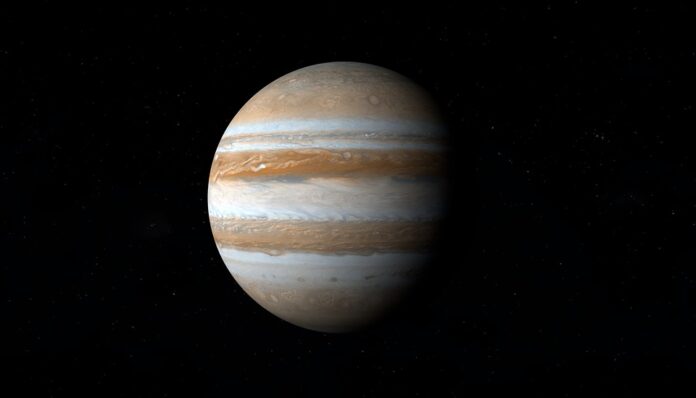
Today, Thursday April 13the European Space Agency (ESA) just launched into space at 2:15 p.m. (Spanish peninsular time) the “Juice” probe to study Jupiter’s icy moons – Callisto, Europa and Ganymede –.
The European mission “Juice”, an acronym for Jupiter Icy Moons Explorer (Explorer of the Icy Moons of Jupiter), will begin an estimated 8-year journey to reach Jupiter aboard an Ariane 5 rocket that will be launched from the Kourou Spaceport, located between the towns of Kourou and Sinnamary, in Guyana. French.
The main objective of this mission will focus on studying in detail this giant gas planet and its three large oceanic moons. Scientists have clear evidence that beneath the ice caps of Jupiter’s icy moons – Callisto, Europa and Ganymede – there are watera fundamental element for there to be life, which makes them potentially habitable.
Claire Vallat, operations scientist of the European mission “Juice” of the European Space Agency (ESA), has commented the following regarding the objective of this mission:
What we want to do with “Juice” is characterize what Jupiter’s icy moons are like. Study how deep these oceans are, what is the salinity of these aquatic environments and know how they interact with the upper layers and with everything that is below said oceans.Claire Vallat
Jupiter and its icy moons
Jupiter is a giant gas planet located about 600 million kilometers from Earth. It is the largest planet in the solar system, as its size is more than twice that of all the other planets in the solar system combined. It is made up of different bands of colored clouds that rotate at dizzying speed in alternate directions, forming its particular atmosphere.
Galileo Galilei, Italian astronomer and physicist, is considered the father of modern science, since he was the discoverer of the four largest moons of Jupiter -Callisto, Europa, Io and Ganymede- in the year 1610, a fact that continues to fascinate astronomers of all ages.
This giant gas planet in our solar system has more than ninety known satellites, among which the four Galilean satellites stand out. Callisto, Europa, Io, and Ganymede, along with Jupiter’s faint ring and a trio of small moons (Amalthea, Metis, and Thebe), form a mini-solar system, with orbits that are circular and flat with respect to the planet’s equator. The discovery of these four large moons ended the belief that the Earth was the center of the universe.

“Juice”, the European mission that will search for life on the icy moons of Jupiter
“Juice” will be the first spacecraft to orbit a moon other than our own (Ganymede), as well as being the first mission to perform a Moon-Earth gravity assist maneuver to save fuel.
The probe will carry out a long journey, although the journey is calculated to the last millimeter. Scientists expect “Juice” to reach Jupiter in July 2031. The probe will remain on this giant gas planet for a minimum of three years, studying even the smallest details.
“Juice” will face great challenges such as the weak sunlight that exists in the Jovian system, as well as its highly harmful environment and its complex trajectory due to the extremely large distance between Earth and Jupiter. Most of the observations will be made on the surface of Ganymede, the satellite on which he will focus most of his work.
To carry out this study, the ship, which weighs six tons, will carry a total of 10 instrumental elements on board, such as cameras, radars and sensors. These systems will be exposed to large temperature differences during their journey, reaching a maximum difference of up to 400ºC.
Scientists have planned the end of the mission for the year 2035, when they hope the probe will have collected all the information necessary to analyze the three satellites and their anchor planet.
In the following table, we show you the dates that the European Space Agency (ESA) has calculated to carry out the observations of this mission:
| Date | Observations |
| April 2023 | The launch of the mission “Juice” will take place |
| August 2024 | Earth-Moon gravitational flybys will take place |
| August 2025 | Gravity flybys of Venus |
| September 2026 | Gravity flybys Earth |
| January 2029 | Gravity flybys Earth |
| July 2031 | “Juice” should be in the orbit of Jupiter |
| year 2034 | It will be the first spacecraft to orbit the moon of another planet |
| year 2035 | The impact will take place on the surface of Ganymede |
What will the Spanish participation in this mission be like?
The Instituto de Astrofísica de Andalucía (IAA-CSIC) is the only Spanish institution participating in this mission, since they built two of the instruments that are part of this mission, the GALA laser altimeter and the JANUS camera.
Luisa Lara, a researcher at the Institute of Astrophysics of Andalusia who is participating in the mission, points out the following:
We are part of the international consortia that are building two of the mission’s instruments, the Janus camera and the Gala altimeter, which will work in a complementary way to study the surface and interior of the satellites. Janus will also analyze the planet’s atmosphere and obtain complementary data with that of other mission instruments.Louise Lara
The immense distances that exist between Earth and Jupiter require a large 2.5 meter diameter antenna on board to guarantee sufficient transmission speeds for downloading scientific data.
Juice’s complex trajectory around Jupiter’s icy moons will include a large number of approach flights that will be assisted by gravity. Finally, it should be noted that entry into orbit around Ganymede will require precise navigation and skillful maneuvering.
Sources: Editorial Ambientum, CSIC, Institute of Astrophysics of Andalusia (IAA-CSIC), ZERO WAVE, RTVE














![[Img #74662]](https://thelatestnews.world/wp-content/uploads/2024/12/Organisms-with-the-shortest-life-300x200.jpg)